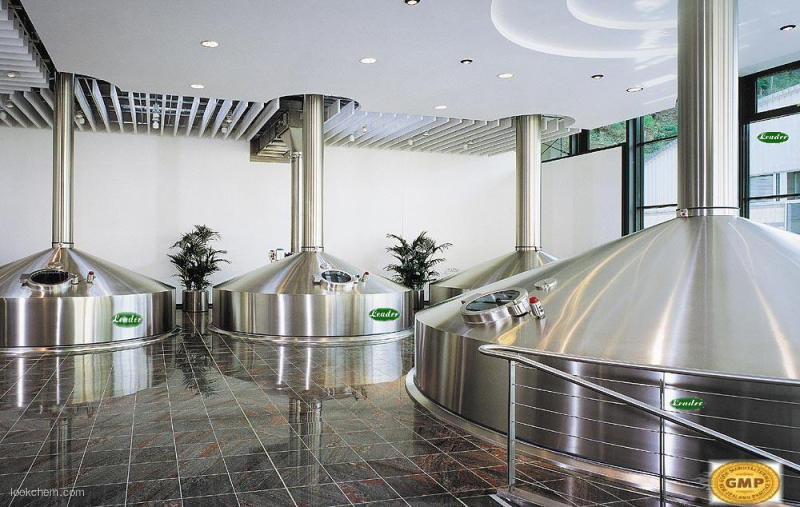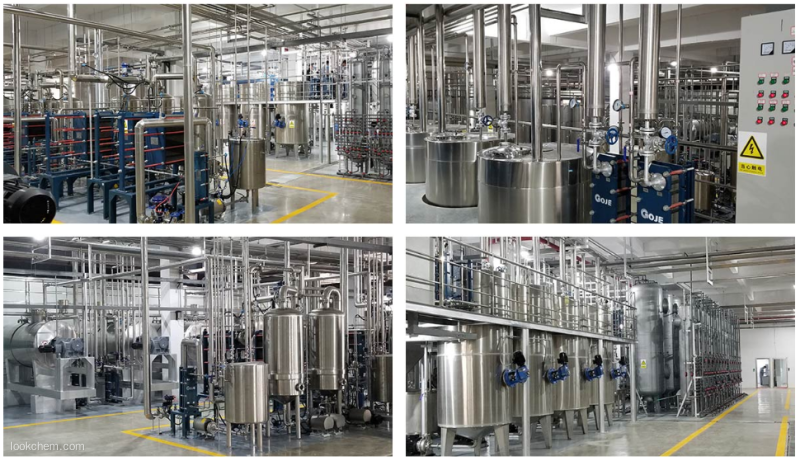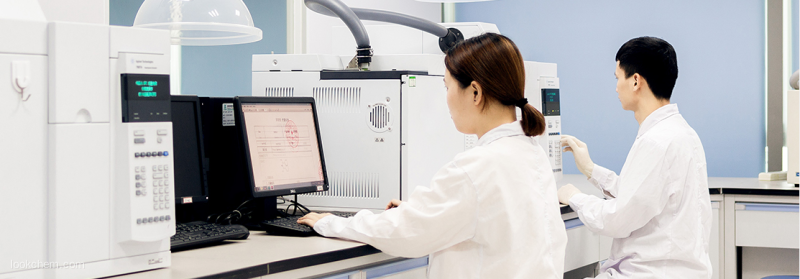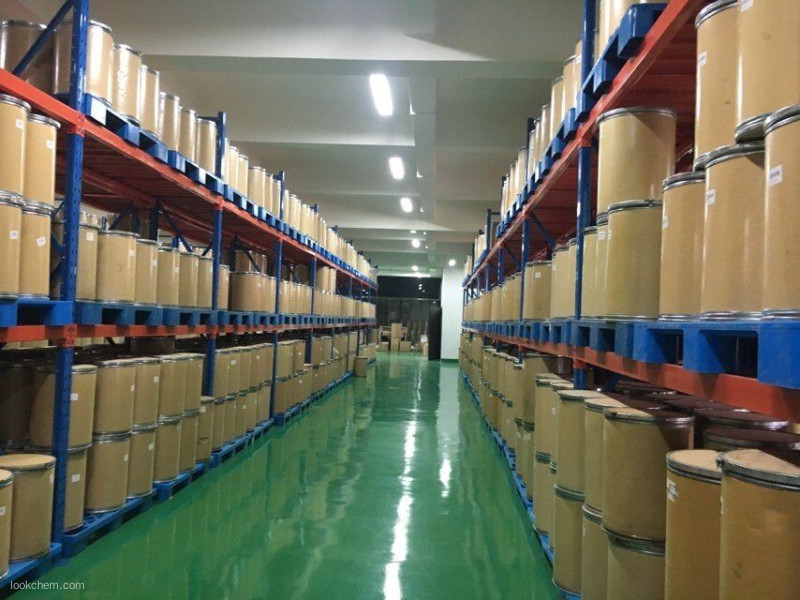PRODUCT DETAILS
| |
| Sarcosine Chemical Properties |
| Melting point |
208-212 °C (dec.)(lit.) |
| Boiling point |
165.17°C (rough estimate) |
| density |
1.1948 (rough estimate) |
| refractive index |
1.4368 (estimate) |
| Fp |
>100℃ |
| storage temp. |
Store below +30°C. |
| solubility |
H2O: 1 M at 20 °C |
| pka |
2.21(at 25℃) |
| form |
Crystals or Powder |
| color |
Colorless or white to yellow |
| PH |
6.1 (100g/l, H2O, 20℃) |
| Water Solubility |
1480 g/L (20 ºC) |
| Sensitive |
Hygroscopic |
| Merck |
14,8373 |
| BRN |
1699442 |
| CAS DataBase Reference |
107-97-1(CAS DataBase Reference) |
| NIST Chemistry Reference |
Sarcosine(107-97-1) |
| EPA Substance Registry System |
Sarcosine (107-97-1) |
| Hazard Codes |
Xi |
| Risk Statements |
36/37/38 |
| Safety Statements |
24/25-36-26 |
| WGK Germany |
1 |
| RTECS |
VQ2897000 |
| F |
3 |
| TSCA |
Yes |
| HS Code |
29224995 |
| Provider |
Language |
| H-Sar-OH |
English |
| ACROS |
English |
| SigmaAldrich |
English |
| ALFA |
English |
| |
| Sarcosine Usage And Synthesis |
| Description |
Sarcosine is the N-methyl derivative of glycine. It can be metabolized to the glycine through sarcosine dehydrogenase. It can be naturally found in many body tissues including muscles. In the laboratory, sarcosine could be synthesized through the reaction between chloroacetic acid and methylamine. Sarcosine is a potential interesting direction for the treatment of mental illness such as schizophrenia, possibly being related to its effect of increasing the glycine content in the brain, which increased the NMDA receptor activity. Sarcosine is also effective in the treatment of depression. Recent study has shown that sarcosine might be an important bio-marker for prostate cancer. |
| Chemical Properties |
Sarcosine, also known as N-methylglycine, is ubiquitous in biological materials and is present in such foods as egg yolks, turkey, ham, vegetables, legumes, etc. It reduced the production of sebum and imperfections linked to hyperseborrhea, thereby refining skin texture. Sarcosine matifies skin perfecting treatments and treatments for oily skin.

Sarcosine is a natural amino acid found in muscles and other body tissues. It is found naturally as an intermediate in the metabolism of choline to glycine. Sarcosine is a white and deliquescence crystalline power. It is sweet to the taste and dissolves in water. It is used in manufacturing biodegradable surfactants and toothpastes as well as in other applications. |
| Biological Functions |
Sarcosine reduces dihydrotestosterone (DHT) by inhibiting the enzyme 5 alphareductase. Sebum production is stimulated by androgens. 5 alpha-reductase metabolises testosterone in the skin into its more potent form dihydrotestosterone (DHT) that is responsible for the overproduction of sebum. As a result, sarcosine reduces shine, tightens and reduces pore size, evens tone and complexion. |
| Uses |
sarcosine is an intermediate in the production glycine from dietary consumption of choline. It is used in making toothpastes and biodegradable surfactants. Sarcosine can be found in foods such as vegetables, ham, egg yolks, turkey and legumes. The normal concentrations of sarcosine in human serum and in human urine are 1.4 µM and 1.6 µM respectively.
Sarcosine has been observed to improve treatment of the mental illness known as schizophrenia: 2 g per day consumption of sarcosine (in addition to antipsychotic drug therapy) results in significant additional reductions not only both positive and negative symptoms, but also general psychopathological and neurocognitive symptoms. Sarcosine is thought to work by increasing glycine concentrations in the brain which causes increased NMDA receptor activation. Interestingly, consumption of sarcosine also reduced depressive symptoms in patients with schizophrenia. A clinical study showed sarcosine to be significantly more effective in treating major depression than the established antidepressant drug Citalopram. |
| Preparation |
Sarcosine is prepared by boiling creatine with an aqueous solution of IO times its weight of barium hydroxide until all odour of ammonia has disappeared. The creatine is decomposed into sarcosine and urea, the latter product being further split up into ammonia and carbonic acid.The excess of barium hydroxide is removed by a current of carbon dioxide, the liquid boiled, filtered, and evaporated to a syrup, from which the sarcosine is deposited in foliated crystals on standing. Sarcosine also results from the action of acids or alkalies on caffeine and theobromine (Vol.VI); and w. Paulmann (Arch. Pharm., 232, 601) recommends the hydrolysis of caffeine as the best method for the preparation of sarcosine, the yield being 60% of the theoretical. |
| References |
#
# |
| Chemical Properties |
White crystalline powder |
| Uses |
Has been found in starfish and sea urchins. It is used as intermediate in the synthesis of antienzyme agents for toothpaste. Found to be a marker for prostate cancer bioagression. |
| Uses |
Sarcosine can improve people's intelligence, especially for exams such as the students need to temporarily increase the effectiveness of intelligence is more obvious. sarcosine can increase muscle strength and anaerobic explosiveness.To prevent damage caused by the brain injury. Sarcosine can effectively improve athletic performance,power, and shorten muscle recovery time. |
| Uses |
sarcosine is a naturally occurring amino acid that is used in cosmetic formulations as a skin conditioner. There are some studies indicating that it is effective for oily skin. Its chemical name is n-methyl glycine. |
| Definition |
ChEBI: A N-alkylglycine that is the N-methyl derivative of glycine. It is an intermediate in the metabolic pathway of glycine. |
| General Description |
Deliquescent crystals or powder. Has a sweetish taste. |
| Air & Water Reactions |
Deliquescent. Water soluble. |
| Reactivity Profile |
Sarcosine is an amide. Amides/imides react with azo and diazo compounds to generate toxic gases. Flammable gases are formed by the reaction of organic amides/imides with strong reducing agents. Amides are very weak bases (weaker than water). Imides are less basic yet and in fact react with strong bases to form salts. That is, they can react as acids. Mixing amides with dehydrating agents such as P2O5 or SOCl2 generates the corresponding nitrile. The combustion of these compounds generates mixed oxides of nitrogen (NOx). Sarcosine is incompatible with acids. . |
| Fire Hazard |
Flash point data for Sarcosine are not available. Sarcosine is probably combustible. |
| Biological Activity |
Endogenous inhibitor of GlyT1 that displays antipsychotic activity. Potentiates the action of glycine on the NMDA glycine binding site. |
| Purification Methods |
Crystallise sarcosine from absolute EtOH, 95% EtOH or H2O. It sublimes at 180-185o/0.3mm with 99.1% recovery [Gross & Gradsky J Am Chem Soc 77 1678 1955]. [Cocker & Harris J Chem Soc 1291 1940, Cocker & Lapworth J Chem Soc 1897 1931, Greenstein & Winitz The Chemistry of the Amino Acids J. Wiley, Vol 3 p 2750 1961, Beilstein 4 III 1121, 4 IV 2363.] |
| |
| Sarcosine Preparation Products And Raw materials |
|
|
|
|
|
|
|
|
|
|
|
|
About US
Leader Biochemical Group is a large leader incorporated industry manufacturers and suppliers of advanced refined raw materials From the year of 1996 when our factory was put into production to year of 2020, our group has successively invested in more than 52 factories with shares and subordinates.We focus on manufacture Pharm & chemicals, functional active ingredients, nutritional Ingredients, health care products, cosmetics, pharmaceutical and refined feed, oil, natural plant ingredients industries to provide top quality of GMP standards products.All the invested factories' product lines cover API and intermediates, vitamins, amino acids, plant extracts, daily chemical products, cosmetics raw materials, nutrition and health care products, food additives, feed additives, essential oil products, fine chemical products and agricultural chemical raw materials And flavors and fragrances. Especially in the field of vitamins, amino acids, pharmaceutical raw materials and cosmetic raw materials, we have more than 20 years of production and sales experience. All products meet the requirements of high international export standards and have been recognized by customers all over the world. Our manufacture basement & R&D center located in National Aerospace Economic & Technical Development Zone Xi`an Shaanxi China. Now not only relying on self-cultivation and development as well as maintains good cooperative relations with many famous research institutes and universities in China. Now, we have closely cooperation with Shanghai Institute of Organic Chemistry of Chinese Academy of Science, Beijing Institute of Material Medical of Chinese Academy of Medical Science, China Pharmaceutical University, Zhejiang University. Closely cooperation with them not only integrating Science and technology resources, but also increasing the R&D speed and improving our R&D power. Offering Powerful Tech supporting Platform for group development. Keep serve the manufacture and the market as the R&D central task, focus on the technical research. Now there are 3 technology R & D platforms including biological extract, microorganism fermentation and chemical synthesis, and can independently research and develop kinds of difficult APIs and pharmaceutical intermediates. With the strong support of China State Institute of Pharmaceutical Industry (hereinafter short for CSIPI), earlier known as Shanghai Institute of Pharmaceutical Industry (SIPI), we have unique advantages in the R & D and industrialization of high-grade, precision and advanced products. Now our Group technical force is abundant, existing staff more that 1000 people, senior professional and technical staff accounted for more than 50% of the total number of employees, including 15 PhD research and development personnel, 5 master′ S degree in technical and management personnel 9 people. We have advanced equipment like fermentation equipment and technology also extraction, isolation, purification, synthesis with rich production experience and strict quality control system, According to the GMP required, quickly transforming the R&D results to industrial production in time, it is our advantages and our products are exported to North and South America, Europe, Middle East, Africa, and other five continents and scale the forefront in the nation, won good international reputation. We believe only good quality can bring good cooperation, quality is our key spirit during our production, we are warmly welcome clients and partner from all over the world contact us for everlasting cooperation, Leader will be your strong, sincere and reliable partner in China.
Our Group profiles
Our Factories production lines



Our Factories R&D ability


Our Factories warehouse




 Premiumsupplier
Premiumsupplier 



